The New Zealand College of Midwives (Inc) supports immersion of women in warm water during labour as a method of pain management.
There is no evidence that remaining in water for the birth of the baby leads to adverse outcomes for the mother or baby where the labour has been within normal parameters.
Definition:
Water birth means where a baby is born fully submerged into water.
Rationale:
• Evidence supports immersion in warm water as an effective form of pain relief that reduces the use of narcotics.
• There is no evidence to suggest that immersion in water during labour or birth in water leads to any detrimental effects for either the mother or her baby.
• Evidence that immersion in water during labour reduces the length of active labour is inconclusive.
• Evidence that birth in water reduces perineal trauma or blood loss is inconclusive.
Guidelines:
Midwives offering water immersion for labour and for birth are responsible for ensuring the information given to women is accurate and up to date.
The following guidelines are recommended:
• There are no adverse factors noted in foetal or maternal wellbeing during labour.
• Baseline assessments of both maternal and baby wellbeing should be done prior to entering the bath/pool and assessments continued throughout the time in water as for any normal labour.
• Vaginal examinations can be performed with the woman in water.
• Pethidine should not be given to women labouring in water.
• The water temperature should be kept as cool as the woman finds comfortable during the first stage of labour (around 35oC) and increased to no more than 37oC for the baby’s birth.
• If maternal temperature rises more than 1oC above the baseline temperature then the water should be cooled or the woman encouraged to leave the bath/pool. Women need to be aware of this in advance.
• Water temperature should be recorded as the woman enters the bath/pool and regularly during the time she remains in the pool.
• Careful documentation should be kept of maternal and water temperatures, FHR and the approximate surface area of the woman’s body submerged.
• The cord should not be clamped and cut until after the birth of the baby’s body.
• The baby should be brought to the surface immediately, with the head facing down to assist the drainage of water from the baby’s mouth and nose.
• The baby’s body can remain in the water to maintain warmth, unless the baby’s condition dictates otherwise. (Note: babies born in water may take slightly longer to establish respirations than those born into air. Maintain close observation of colour, heart rate and respirations.)
• Third stage should be managed physiologically as for any other low risk birth. If oxytocin is required or third stage is prolonged the woman is assisted to leave the bath/pool.
• Midwives must ensure that baths and pipes are thoroughly cleaned after use.
References:
Title: Labour and delivery in the birthing pool
Author: Forde, C, Creighton, S, Batty, A, Howden, J, Summers-Ma, S, and Ridgeway, G
Title: Warm tub bathing during labour: maternal and neonatal effects
Authors: Ohlsson, G, Buchave, P, Leandersson, U, Nordstrom, L, Rydhstrom, H, and Sjolin, I
Source: Acta Obstetricia et Gynecologica Scandinavica, Vol 80, pp 311 – 314, 2001
Title: Immersion in water in the first stage of labour: a randomised controlled trial
Authors: Eckert, K, Turnbull, D, and MacLennan, A
Source: Birth, Volume 28, No 2, pp 84–93, June 2001
Title: Immersion in water during first stage of labour
Author: Homer, C
Source: Letter to the editor, Birth, Vol. 29, No 1, March, 2002
Title: Waterbirths: a comparative study. A prospective study on more than 2000 waterbirths Authors: Geissbuhler, V and Eberhard, J
Source: Foetal Diagnosis Therapy, Vol. 15, pp. 291 – 300, 2000
Title: Immersion in water in pregnancy, labour and birth Author: Nikodem, VC
Source: Cochrane Database Systematic Review, 2000
Title: Perinatal mortality and morbidity among babies delivered in water: surveillance study and postal survey
Authors: Gilbert, R and Tookey, P
Source: British Medical Journal, 319 (7208), pp. 483 – 487, 1999
Title: Birth under water – to breathe or not to breath
Author: Johnson, P
Source: British Journal of Obstetrics and Gynaecology, 103, 202-208, 1996
Title: Labour and birth in water: temperature of pool is important
Authors: Deans, AC and Steer, PJ
Source: British Medical Journal. 311:390-391, 1995
Title: Waterbirth – An attitude to care
Author: Garland, D
Source: Books for Midwives, 1995. Chesire
Title: Foetal hypothermia risk from warm water immersion
Author: Charles, C
Source: British Journal of Midwifery
The purpose of New Zealand College of Midwives Consensus Statements is to provide women, midwives and the maternity services with the profession’s position on any given situation.
The guidelines are designed to educate and support best practice.
All position statements are regularly reviewed and updated in line with evidence-based practice.










